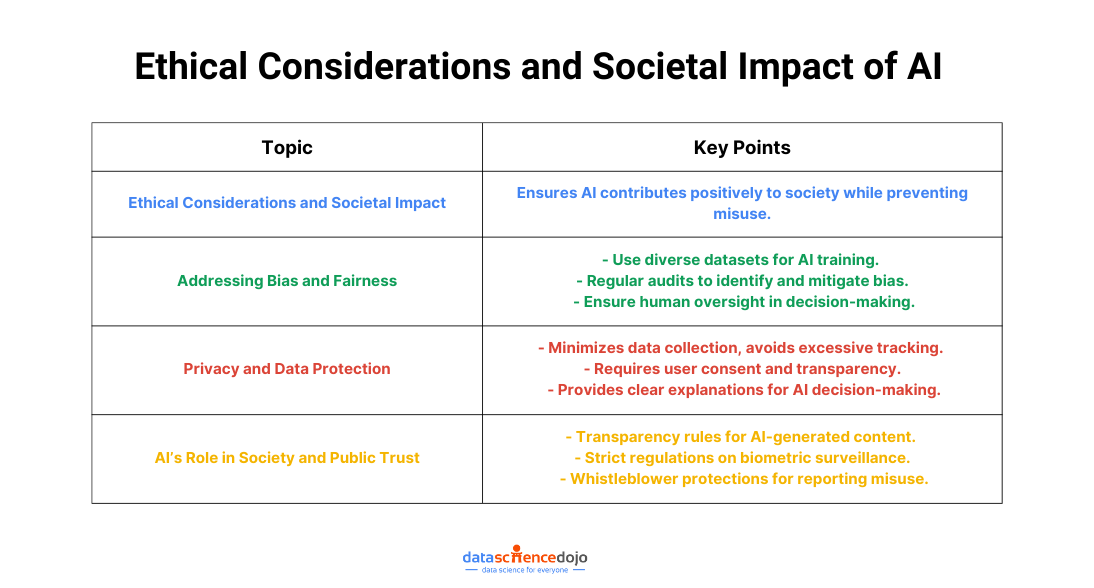Welcome to Data Science Dojo’s deep dive into the EU AI Act—the world’s first comprehensive regulatory framework for artificial intelligence. In this blog, we break down how the EU’s risk-based approach categorizes AI systems—from minimal and limited to high and unacceptable risk—and what that means for businesses, developers, and everyday users.
Learn how the Act sets strict compliance and transparency requirements to protect fundamental rights while fostering innovation, and discover practical guidelines to help you navigate this new regulatory landscape. Whether you’re an AI practitioner or a tech enthusiast, this guide is your essential resource for understanding how Europe is shaping the future of AI.
Key Aspects of the EU AI Act
- Risk-based classification: AI systems are classified according to their potential risk, with specific regulations tailored to each category. This includes prohibited, high-risk, and lower-risk AI systems, ensuring a balanced approach that considers both innovation and safety.
- Prohibitions and restrictions: Certain uses of AI are banned, including those that pose unacceptable risks, such as cognitive behavioral manipulation and social scoring. Additionally, restrictions are placed on the use of facial recognition technology in public spaces.
- Human oversight and rights protection: The act emphasizes the need for human oversight in AI decision-making processes and the protection of fundamental rights. This is crucial to prevent potential abuses and ensure that AI systems do not infringe on individual liberties.
- Transparency and accountability: Transparency in how AI systems operate and their decision-making processes is mandated, along with accountability mechanisms. This is essential to building trust and allowing for effective oversight and control.
Do you know about these -> Top AI inventions of 2023
Statements from Officials
-
Ursula von der Leyen, President of the European Commission, emphasized the AI Act’s role in ensuring safe AI that respects fundamental rights and democracy.
-
Commissioner Breton highlighted the historic nature of the act, which positions the EU as a leader in setting clear rules for AI use.
Provisions of the AI Act Regarding High-Risk AI Systems

Under the AI Act, high-risk AI systems face more stringent rules and regulations to ensure their safe use. High-risk AI systems are those that have a significant impact on safety or fundamental rights.
These systems fall into either of two broad categories.
- The first category includes AI systems used in products that come under the EU’s product safety legislation, which encompasses fields as diverse as toys, aviation, cars, and medical devices.
- The second category covers eight specific areas, including biometric identification of natural persons, management of critical infrastructure, education and vocational training, employment and access to self-employment, law enforcement, and legal matters, among others.
To ensure the safety and transparency of these high-risk AI systems, the AI Act mandates that all such systems be extensively evaluated before being introduced to the market and subject them to consistent monitoring throughout their operational lifecycle.
This prior verification aims at ensuring compliance with important provisions concerning the quality of datasets used, technical and documentation requirements, transparency and provision of information to users, and effective oversight.
Overall, the EU framework imposes extensive obligations on both providers and users of high-risk AI systems. By implementing stringent measures, it ensures that businesses and individuals using these systems do so responsibly and safely, promoting trust in AI technologies while ensuring consumer protection.
Compliance Guidelines and Support for Organizations
As organizations across the European Union adapt to the AI Act, compliance becomes a key priority. The regulation classifies AI systems based on risk, imposing stringent requirements on high-risk applications while outright banning certain AI practices deemed too dangerous. Businesses operating within the EU—or those deploying AI solutions that affect EU citizens—must ensure they align with these new legal frameworks.
Steps to Ensure Compliance
-
Assess AI System Risk Classification
- Determine whether your AI application falls into prohibited, high-risk, limited-risk, or minimal-risk categories under the AI Act.
- Use official compliance tools such as the AI Act Compliance Checker to evaluate your organization’s status.
-
Implement Mandatory Documentation and Transparency Measures
- High-risk AI systems must provide detailed technical documentation, risk assessment reports, and human oversight mechanisms.
- AI-generated content should include clear disclosure statements where applicable.
-
Strengthen Data Governance and Bias Mitigation
- Organizations need robust data management policies to prevent biased AI outcomes.
- Compliance requires a commitment to fairness, non-discrimination, and transparency in AI decision-making.
-
Develop Internal Compliance Teams
- Assign dedicated compliance officers or legal teams to oversee EU framework adherence.
- Stay informed about updates and amendments that could affect AI regulations.
-
Use AI Act Compliance Tools
- The AI Act Compliance Checker helps businesses identify their regulatory obligations.
- National regulatory bodies are also expected to release further guidelines and compliance frameworks in the coming months.
Failure to comply with the AI Act can lead to significant fines, with penalties reaching up to €35 million or 7% of global annual turnover, making strict adherence essential.
Ethical Considerations and Societal Impact

As artificial intelligence becomes increasingly integrated into everyday life, the ethical implications of AI regulation take center stage. The EU AI Act is designed not just to prevent misuse but to ensure AI contributes positively to society.
Addressing Bias and Fairness
One of the major concerns in AI systems is algorithmic bias, which can result in discrimination against certain groups. The AI Act requires that developers:
- Use diverse and representative datasets to train AI models.
- Conduct regular audits to identify and mitigate bias.
- Ensure human oversight in decision-making processes to prevent automated discrimination.
Privacy and Data Protection
With AI relying heavily on big data, privacy becomes a crucial concern. The AI Act complements the General Data Protection Regulation (GDPR) by:
- Ensuring AI systems minimize data collection and avoid excessive tracking.
- Mandating user consent and transparency for data-driven AI applications.
- Requiring companies to provide clear explanations when AI is used in decision-making.
Explore more about big data ethics
AI’s Role in Society and Public Trust
Public perception of AI is a determining factor in its acceptance. The AI Act promotes ethical AI deployment through:
- Transparency rules, ensuring AI-generated content is labeled as such.
- Strict regulations on biometric surveillance, reducing the risk of mass surveillance abuse.
- Whistleblower protections, allowing employees to report AI misuse without fear of retaliation.
By addressing these ethical considerations, the AI Act ensures that AI-driven technologies serve humanity responsibly and fairly.
Need for AI regulation
- Ethical and safe development: The AI Act aims to ensure that AI development aligns with EU values, including human rights and ethical standards.
- Consumer and citizen protection: By regulating AI, the EU aims to protect its citizens from potential harm caused by AI systems, such as privacy breaches or discriminatory practices.
- Fostering innovation: The act is designed not only to regulate but also to encourage innovation in AI, positioning Europe as a global hub for trustworthy AI.
- Global impact: The EU AI Act is expected to have a significant global impact, influencing how AI is regulated worldwide and potentially setting a global standard for AI governance.
Also learn about the environmental impact of AI
Future Outlook and Potential Amendments
The AI Act marks the beginning of an evolving regulatory landscape. As AI technology advances, the legislation will require ongoing updates and amendments to address new challenges.
Potential Future Changes
-
Expansion of High-Risk AI Categories
- Currently, high-risk AI applications include critical infrastructure, education, employment, and law enforcement.
- Future amendments may expand this to cover autonomous weapons, AI-driven misinformation, and more advanced deepfake detection measures.
-
Stricter Regulations for Generative AI
- The AI Act already requires transparency in AI-generated content, but upcoming amendments may introduce:
- Mandatory watermarking of AI-generated images and videos.
- Greater scrutiny of AI chatbots and virtual assistants to prevent misinformation.
- The AI Act already requires transparency in AI-generated content, but upcoming amendments may introduce:
-
Global Harmonization with Other AI Regulations
- The AI Act will likely influence AI laws outside Europe, prompting global AI governance efforts.
- Future amendments may seek greater alignment with U.S. and Asian AI policies to create a more standardized global framework.
-
Increased Investment in AI Innovation
- The EU has proposed a €50 billion AI innovation fund to support companies in developing ethical AI solutions.
- Future amendments could introduce tax incentives and grants to encourage compliance while fostering AI development.
As AI technology continues to evolve, so will its regulations. Organizations must stay proactive and adaptable, ensuring they remain compliant while leveraging AI’s full potential.
Conclusion
By integrating compliance tools, addressing ethical concerns, and anticipating future amendments, businesses can successfully navigate the evolving AI regulatory landscape. The EU framework is more than just a legal guideline—it is a blueprint for responsible AI development that will shape the future of artificial intelligence across industries.





